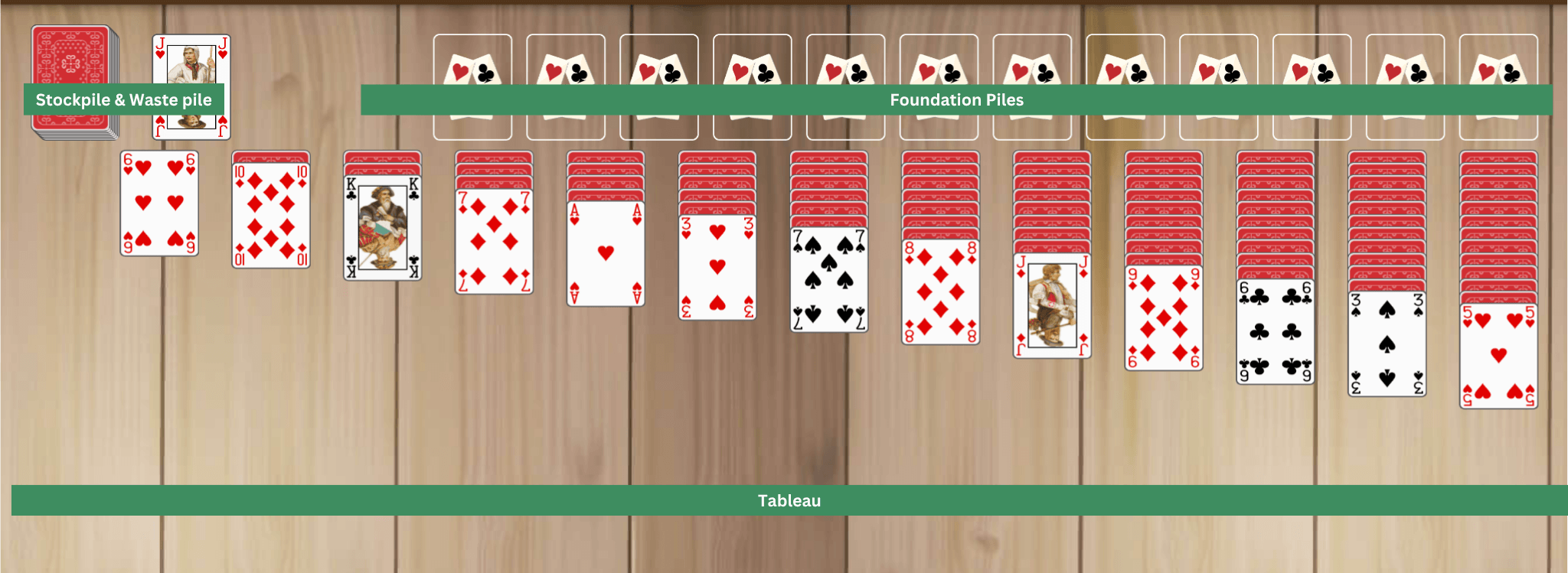How to Play Triple Solitaire
Triple Solitaire, or Triple Klondike, is the same game as
Classic Solitaire, except that it is played
with three decks, or 156 cards. It takes much longer to solve than Classic Solitaire because you have more cards
to work with; however, it also means you have a higher chance of winning.
The Goal
Your goal is to move all 156 cards from the stockpile and tableau into the eight foundation piles by suit in
ascending order from ace to king. There are three foundation piles for each suit.
The Setup
-
Tableau: This is where you sequence face-up cards and uncover face-down cards. 91 cards are laid down
in 13 columns, with the first column having 1 card, the second column with 2 cards, and so forth until the
9th column has 9 cards, forming a reverse staircase. The last card of each column is placed face-up.
-
Stockpile: The remaining 65 cards are placed face down in the stockpile, which is located at the top
left of the game.
-
Waste pile: Cards from the stockpile are moved to the waste pile one by one. The last face-up card in
the waste pile can be moved to the foundation piles or the tableau.
-
Foundation piles: These are the 12 piles above the tableau. Cards are moved to the foundation by
suit, in ascending order from Ace to King.

Triple Solitaire Rules
Gameplay is similar to Classic or Klondike Solitaire.
-
Only move face-up cards: You can move cards from the bottom of the tableau columns. When you uncover
facedown cards in the tableau, they are turned face up and can then be played. Face-up cards in the waste
pile are also playable.
-
Sequence cards in descending order, alternating by color. For example, a 5 of spades can be placed on
a 6 of hearts.
-
Move a sequence of cards in descending order and alternating color as a group. For example, if you
have a sequence containing the 5 of spades, 4 of diamonds, and 3 of spades, you can move it on top of a 6 of
diamonds in another tableau column.
-
Draw from the stockpile when stuck. If you can't make any more moves in the tableau, flip a card from
the stockpile to the waste pile. This face-up card can be used if moves are available. Once the stockpile
has run out, the waste pile cards are flipped back into the stockpile to run through it again. You can go
through it as many times as you want. In turn 1 of Triple Klondike, you draw one card at a time.
-
Fill empty columns with kings. When you empty a column, you can fill it with a king or a sequence
that starts with a king. No other cards can start empty columns.
-
Build foundation piles. Foundation piles are built by suit. Start each foundation pile with an ace
and continue building in ascending order (A, 2, 3, 4, 5, 6, 7, 8, 9, 10, J, Q, K) until each of the 12
foundation piles is complete and you've cleared the tableau and stockpile.
Strategy
-
Immediately draw a card from the stockpile. This gives you one more card you know that you can play
into the tableau and help build sequences.
-
Study the tableau. Examine all the cards in the tableau to gain an understanding of where they are
and potential future moves. There are many more cards than in Classic Solitaire, so take your time to
understand the tableau.
-
Move aces and 2s to the foundation. Playable aces can always be immediately moved to the foundation,
freeing up more cards. Additionally, move 2s immediately to the foundation if you can. 2s can't help
sequence other cards, so you'll want to remove them from the tableau as soon as you can to free up other
cards.
-
Prioritize moves in the tableau. Before using cards in the waste pile, make as many moves in the
tableau as possible. This helps you uncover facedown cards and clear columns, instead of prematurely adding
cards in the tableau that could limit your options and block future moves.
-
Prioritize moves that free face-down cards. Uncovering facedown cards allows them to be flipped face
up, increasing possible moves.
-
Focus on uncovering cards in long tableau columns. These columns contain more hidden cards, which are
important to reveal to progress through the game.
-
Build foundation piles evenly. If one foundation pile is built up significantly more than the others,
it can make sequencing cards in the tableau difficult.
-
If needed, move cards back to the tableau from the foundation. You may find you'll need a card
already in the foundation to sequence and reveal cards in the tableau.
-
Create sequences using the same pairs of suits when possible. If you can build sequences using
diamonds and spades, for example, it’s easier to move them into foundation piles evenly.
-
Look ahead at gaps in sequences. It’s best to move waste pile cards to the tableau only when they can
further gameplay. To help decide, look for gaps in sequences. For example, if there is a king of spades and
queen of hearts in one column and a ten of diamonds and nine of spades in another column, moving the jack of
clubs from the waste pile to the tableau is beneficial because it will help you build a more complete
sequence.
Similar games to try
Try Turn 3 Triple Solitaire, which is the same
game, but you draw 3 cards at a time. You might also like
Double Solitaire which is played with two
decks of cards and is a faster game to complete.



